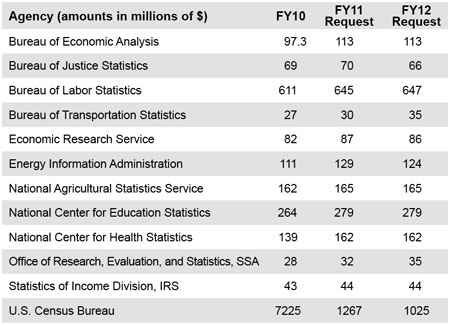Administration Affirms Role of Data-Driven Decisionmaking with FY12 Budget Requests
Steve Pierson, ASA Director of Science Policy
In President Obama’s fiscal year 2012 (FY12) budget request, released on February 14, the federal statistical agencies’ budgets generally see the increases requested for FY11 request postponed a year. Acknowledging the atmosphere of fiscal restraint and the uncertainty around the still unresolved FY11 budget, the administration largely affirms its belief in the value of the federal statistical system through the FY12 request.
As the table above illustrates, the National Center for Health Statistics, Energy Information Administration (EIA), and Bureau of Economic Analysis still see the large increases requested for FY11 (over FY10) in the FY12 request, although EIA’s requested increase is more modest. The small increases requested in FY11 for the Bureau of Labor Statistics, Economic Research Service, and National Center for Education Statistics also are mostly left intact in the FY12 request.
The Bureau of Transportation Statistics (BTS) and Social Security Administration’s Office of Research, Evaluation, and Statistics (ORES) both see larger requested increases in the FY12 request.
With its 30% requested increase, BTS would establish a safety data analysis program to “centralize, standardize, and address gaps in safety data” across all transportation modes. It also would expand the sample for the Commodity Flow Survey and conduct the Vehicle Inventory and Use Survey—last conducted in 2002—on the physical and operating characteristics of trucks on the nation’s roads.
With its 25% requested increase, ORES would “expand disability research by creating a disability research consortium and commissioning expert studies on critical program design issues.”
The Bureau of Transportation Statistics (BTS) and Social Security Administration’s Office of Research, Evaluation, and Statistics (ORES) both see larger requested increases in the FY12 request.
The main exceptions to the trends above are the U.S. Census Bureau and Bureau of Justice Statistics (BJS). The Census Bureau’s FY12 request is $1.025 billion, down from the $1.267 billion request for FY11, largely because of the continued wrap-up of the 2010 decennial census. The FY12 request continues the FY11 request plans to increase the sample size of the American Community Survey and continue developing the supplemental statistical poverty measure. Other major programs seeing increases in the FY12 request include the 2012 Economic Census, planning for the 2020 decennial census, and enhancing the statistical agencies’ ability to use administrative records.
The BJS budget request is $3 million below the FY10 level and $4 million below the FY11 request, but still substantially above the FY09 level in order to continue revitalizing the National Crime Victimization Survey.
It’s essential for the statistical community to communicate the importance of the statistical agencies to Congress. The following excerpt from the opening paragraph of the Strengthening Federal Statistics chapter of the FY12 Analytical Perspectives says it well:
For sources of request levels and further information, see the blog post “FY12 Statistical Agency Budget Requests” at ASA’s community blog.


















